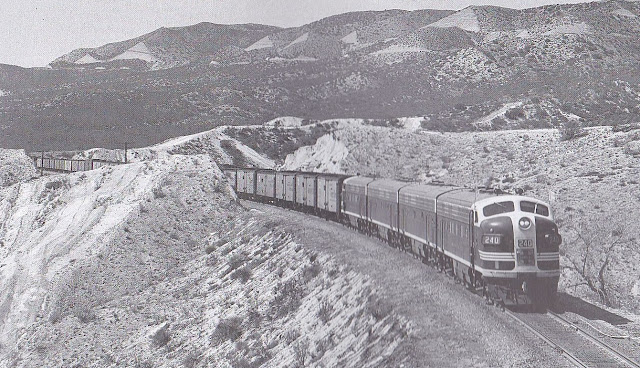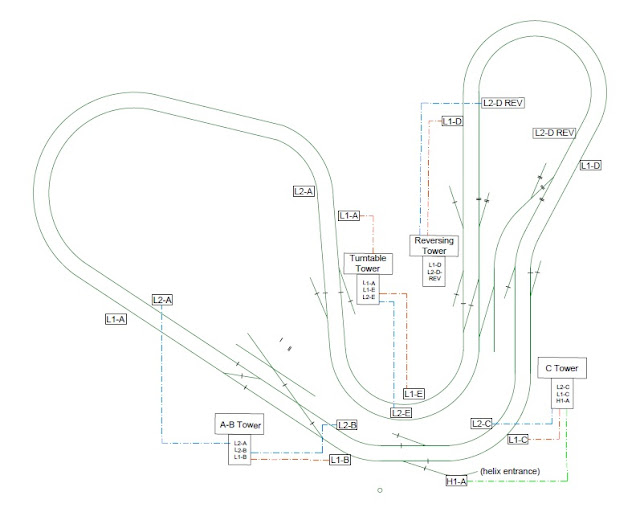I thought I had covered Santa Fe's freight F7s (back on June 26 of 2022), but I recently discovered that I hadn't yet covered the later ones (#233 and higher), so I'll do that now. Also, I'll cover some slow progress on the layout wiring and the addition of some new Victorville structure models built by friends.
When we left off with the freight F7s, we had covered the "Phase 1 Early" units, ABBA sets #202 to 232. Next came the "Phase 1 Late" sets (#233 to #268), which were built in groups in April-May 1950 (#233-241), in Jan.-Feb. 1951 (#242-251), in May 1951 (#252-258), and in Aug.-Sep. 1951 (#259-268). Finally, there was a group of "Phase 2" sets built in Nov.-Dec. 1953 (269-280).
Let's look at some of these in action in Victorville and on Cajon Pass when they were still fairly new.
Stan Kistler got a magnificent shot of new F7 set #234 leaving Victorville with a westbound freight, coming through the Upper Narrows in May, 1951:
Here's a rare shot by Robert Hale, showing single F7A #242 helping 4-8-4 #2929 with the 2nd section of the westbound Grand Canyon on the Frost flyover in Dec. 1951, after leaving Victorville:
Here's a beautiful shot I found in an eBay slide set years ago, showing a swing brakeman near the grade crossing in Victorville, about to board a westbound freight behind new F7 set #249 in 1951 or a bit later:
Here we see F7 set #257 with a westbound freight entering the curve at the west end of Summit in 1951, thanks again to Robert Hale:
Stan Kistler shot F7 set #240 with an eastbound train of reefers (probably the GFX train) approaching Summit in 1951:
Here we see F7 set #261 with an eastbound Boy Scout Special climbing from Cajon (in the background) towards Sullivan's Curve in July of 1953, thanks to Robert Heuerman:
So far, all the photos have shown the locos in their original "cat whisker" paint scheme. But the later units (#269 and up) came with the chrome yellow "cigar band" scheme in late 1953, and starting in 1954 the earlier units were repainted into that new scheme.
Here we see F7 set #239 (now in cigar band paint) with an eastbound freight at Cajon in May of 1955, thanks to C.H. Kerrigan:
Finally, here we see late F7 set #276 (which came painted in cigar band) with a westbound freight at Pine Lodge in Dec. 1955, as shot by Homer Benton:
As for HO models of these locos, I wasn't able to find many photos online, so I'm referring to my clinic notes on freight F-units. They say that F7 Phase 1 Late models were made by Intermountain (both paint schemes), by Proto 2000 in cigar band (but with 1960's grab irons), and by Stewart (but undecorated).
Athearn Genesis made a model of #260LABC in cigar band (and I have it), but B-unit #260A should have a steam generator. Stewart made a model of an F7 Phase 2 set (but undecorated).
Since then, Walthers Mainline has made a model of #255LA in cigar band, with a steam generator in the B unit:
And on the market now is an Athearn Genesis model of #257LA in catwhisker paint, with a steam generator in the B unit:
Now it's time to look at my layout progress over the last two weeks.
Meanwhile, I worked on the suitcase connectors on the other side of the room:
I had to be sure his freight doors would be at the right height to match a boxcar's doors when sitting on the spur track beside the building. Here's an actual trackside photo of this building in later years, as shot by fellow Victorville modeler Wayne Lawson:
Bill also brought along his completed, scratchbuilt model of the second section house that stood by the water tanks in Victorville. We have only partial photos of this building, but he deduced the rest based on his knowledge of Santa Fe section house architecture. He placed the model on our paper map of the area, and I shot a photo of the track side (which we believe was the back porch side):
Note that we decided not to have any doors or windows on the end wall after all, since we don't see any in the one and only partial aerial view that we have. Here's his photo of the track side, which is much improved from a week ago:





















No comments:
Post a Comment